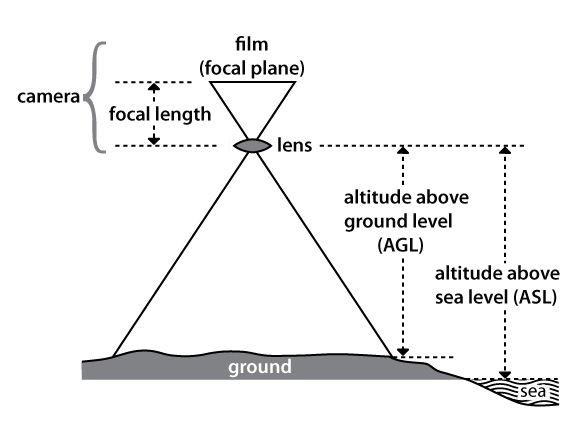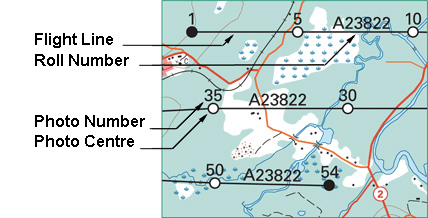What is an aerial photograph?
An aerial photograph, in broad terms, is any photograph taken from the air. Normally, air photos are taken vertically from an aircraft using a highly-accurate camera. There are several things you can look for to determine what makes one photograph different from another of the same area including type of film, scale, and overlap. Other important concepts used in aerial photography are stereoscopic coverage, fiducial marks, focal length, roll and frame numbers, and flight lines and index maps. The following material will help you understand the fundamentals of aerial photography by explaining these basic technical concepts.
Basic Concepts of Aerial Photography
Film: most air photo missions are flown using black and white film, however colour, infrared, and false-colour infrared film are sometimes used for special projects.
Focal length: the distance from the middle of the camera lens to the focal plane (i.e. the film). As focal length increases, image distortion decreases. The focal length is precisely measured when the camera is calibrated.
Scale: the ratio of the distance between two points on a photo to the actual distance between the same two points on the ground (i.e. 1 unit on the photo equals "x" units on the ground). If a 1 km stretch of highway covers 4 cm on an air photo, the scale is calculated as follows:

Another method used to determine the scale of a photo is to find the ratio between the camera's focal length and the plane's altitude above the ground being photographed.

If a camera's focal length is 152 mm, and the plane's altitude Above Ground Level (AGL) is 7 600 m, using the same equation as above, the scale would be:

Scale may be expressed three ways:
- Unit Equivalent
- Representative Fraction
- Ratio
A photographic scale of 1 millimetre on the photograph represents 25 metres on the ground would be expressed as follows:
- Unit Equivalent - 1 mm = 25 m
- Representative Fraction - 1/25 000
- Ratio - 1:25 000
Two terms that are normally mentioned when discussing scale are:
Large Scale - Larger-scale photos (e.g. 1:25 000) cover small areas in greater detail. A large scale photo simply means that ground features are at a larger, more detailed size. The area of ground coverage that is seen on the photo is less than at smaller scales.
Small Scale - Smaller-scale photos (e.g. 1:50 000) cover large areas in less detail. A small scale photo simply means that ground features are at a smaller, less detailed size. The area of ground coverage that is seen on the photo is greater than at larger scales.
The National Air Photo Library has a variety of photographic scales available, such as 1:3 000 (large scale) of selected areas, and 1:50 000 (small scale).
Fiducial marks: small registration marks exposed on the edges of a photograph. The distances between fiducial marks are precisely measured when a camera is calibrated, and this information is used by cartographers when compiling a topographic map.
Overlap: is the amount by which one photograph includes the area covered by another photograph, and is expressed as a percentage. The photo survey is designed to acquire 60% forward overlap (between photos along the same flight line) and 30% lateral overlap (between photos on adjacent flight lines).

Stereoscopic Coverage: the three-dimensional view which results when two overlapping photos (called a stereo pair), are viewed using a stereoscope. Each photograph of the stereo pair provides a slightly different view of the same area, which the brain combines and interprets as a 3-D view.
Roll and Photo Numbers: each aerial photo is assigned a unique index number according to the photo's roll and frame. For example, photo A23822-35 is the 35th annotated photo on roll A23822. This identifying number allows you to find the photo in NAPL's archive, along with metadata information such as the date it was taken, the plane's altitude (above sea level), the focal length of the camera, and the weather conditions.
Flight Lines and Index Maps: at the end of a photo mission, the aerial survey contractor plots the location of the first, last, and every fifth photo centre, along with its roll and frame number, on a National Topographic System (NTS) map. Photo centres are represented by small circles, and straight lines are drawn connecting the circles to show photos on the same flight line.
This graphical representation is called an air photo index map, and it allows you to relate the photos to their geographical location. Small-scale photographs are indexed on 1:250 000 scale NTS map sheets, and larger-scale photographs are indexed on 1:50 000 scale NTS maps.
